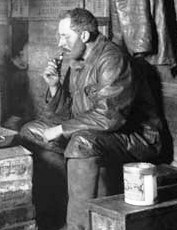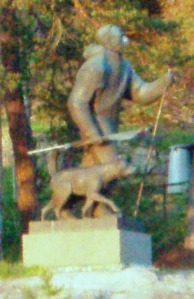Lying in their bunks, as the inevitable darkness of winter began to arrive, a member of the British Antarctic Expedition scribbles the latest score of their teams attempt to reach the South Pole.
The figures aren’t promising, and as the team prepares to search for their missing party the following summer, their hope of reuniting with their countryman continues to fade along with sun, whose dim glow is barely visible on the horizon. Only after the burial of old-man winter, can the team set out to discover the fate of their comrades, who had partaken in what would become the last great race on earth.
It would take the team months to retrace the footsteps of their leader, Captain Robert Falcon Scott and four other team members who had set out to stake the unclaimed pole for the crown.
As the search team trudged through thick snow, over steep glaciers, and around deep crevasses, their last morsels of hope were being swallowed, as they too struggled across the vast frozen continent.
On November 12, 1912, they spotted the half buried tent of their captain, and were finally forced to stomach the grim reality that their commander had not survived his unworldly voyage.
The canvas tent, upheld only by bamboo poles, had survived the long winter and preserved the body of Scott. Lying stoically atop his sleeping bag with an open coat, he was nestled between the two remaining members of the original crew who lay covered by their bags “as if they were dozing.”
Scott was instantly immortalized as a tragic hero, but only after the inspection of his journals, had the extent of this tragedy come to be realized. If the starving, freezing death of these men wasn’t painful enough for the searching team, it the loss of the pole that added insult to their injury.
——————————————————————————————-
The Polar Regions are the two most pristine places remaining on earth. Both their extreme climates and breathtaking beauty make these places intriguing to most, but it is their virgin landscapes and unique ecosystems make them a priceless theater for scientists. Luckily, both professors and policy makers alike have recognized this aspect, and have put measures in place to ensure that these regions remain both scientifically legitimate and productive for future generations.
1961 saw the enactment of the Antarctic Treaty, a document that has expanded to protect the peace, science, and environment in Antarctica. Additionally, there are specific of periods of international awareness, cooperation, and funding that catalyzes this scientific advancement.
These International Polar Year’s (IPY’s) take place every 50 years, with the IPY last occurring in the 2007/08 Antarctic season.

June 6, 2010 – Descendents of Amundsen gather at his house to mark the centennial of his voyage. On a dinner cruise, we witnessed the festivities from the same spot Amundsen departed exaclty 100 yrs earlier.
The cumulating event for the latest IPY took place this past June in Oslo, Norway, and I was chosen to attend as teacher, complimenting the other 2,500 scientists, educators, and interested parties at the world’s largest gathering of polar scientists, ever.
It was then that I became acquainted with Norway; a beautiful country with wonderful people, but it was one person in particular whom I came to know from afar, that made this amazing race to the bottom all the more personal.
Roald Amundsen was born near Oslo in 1872. As the youngest son, he was pressured to study medicine, only to drop out of school after the death of his mother to pursue a career on the most frigid of the high seas.
Amundsen became the first to cross the Northwest Passage while captain of the Goja. This success undoubtedly fueled his appetite for polar exploration, and upon return, Amundsen organized a second venture to reach the North Pole.
He would be beaten in this quest however, as news spread of American, Robert Perry’s claim to the North Pole, a fact that is still disputed today.
Regardless, Amundsen proceeded planning his expedition to the North, changing the focus from an expedition of discovery to an expedition of science, thus allowing him to keep the funding, and the boat, that he had already been pledged.
Only Amundsen knew, however, that “it was with clear conscience that [he] would postpone the original plan, and try to solve the last great problem… the South Pole.”
He had been promised the Fram, the boat owned by another famed Norwegian explorer, Fridtjof Nansen. However, neither Fram’s owner, nor her crew was aware of the upcoming about-face their voyage was going to take, and on June 6, 1910 Amundsen left Oslo, on an embezzled boat with captured crew, on what would unknowingly become the greatest, coldest quest of their young lives.
Ironically, the courses to both the North and South Pole were initially the same, buying Amundsen time before notifying the Fram that her keel would ultimately go to the southern ocean.
It wasn’t until a planned stop to Madeira, Portugal that the crew was informed of the change of course, and only with all on board consenting, sent a candid message to Scott saying, “I beg leave inform you, proceeding Antarctic. Amundsen.”
A month would pass before Scott received word of the Amundsen’s altered course, a telegram that deeply troubled him and his crew. The extent of their troubles would not be realized, however until January 17, 1912, after reaching the pole, 34 days after the crazed Norwegian.
“Great God, this is an awful place,” a feeling warranted by the Norwegian flag flying atop the small tent marking camp Polheim. This “home at the pole” was christened by Amundsen, who with his team of five men and eighteen dogs had staked claim to the spot that so narrowly evaded Scott and his country.

Cape Evans is located about 12 miles North of McMurdo. Scott and 24 others lived in this hut. Must have a cozy place to spend an Antarctic Winter
“All the day dreams must go. It will be a wearisome return,” was the precognitive journal entry that marked the beginning of the end for Scott and his party.
Their long march home was wrought with blinding snow, insufficient supplies, and frostbitten limbs, as the five man team gradually shriveled down to three.
Those remaining grew weaker by the everlasting day, and their hopes of survival diminished as they desperately plodded in the direction of Cape Evans.
——————————————————————————————-
“They died having done something great. How hard must not death be, having done nothing,” mustered a member of the search party as they lowered the tent over the three frozen men.
As the team buried their comrades in a tomb of snow, these thoughts of valor were second only to thoughts of their own fortune.
Onward Christian Soldier was sung aloud, while the search team placed a pair of crossed skis atop the white frozen veil to mark the resting spot of their fateful companions. As they read from the book of Corinthians, not a single soldier queried the bravery of their countrymen, but all undoubtedly questioned their fate, as they would forever lie buried, hungry and frozen, a lifetime away from their homeland, but only 11 miles away from a supply cache with food and fuel.

Mississippi born and raised, Mark Walsh spends his time these days in Antarctica as a weather weather observer at McMurdo Station. The Frozen Toe is an outlet for his stories, photos and observations about life on the ice. He is also the founder of Barefoot Wallets, wallets for the adventure traveler, which comes in an assortment of colors and designs.













